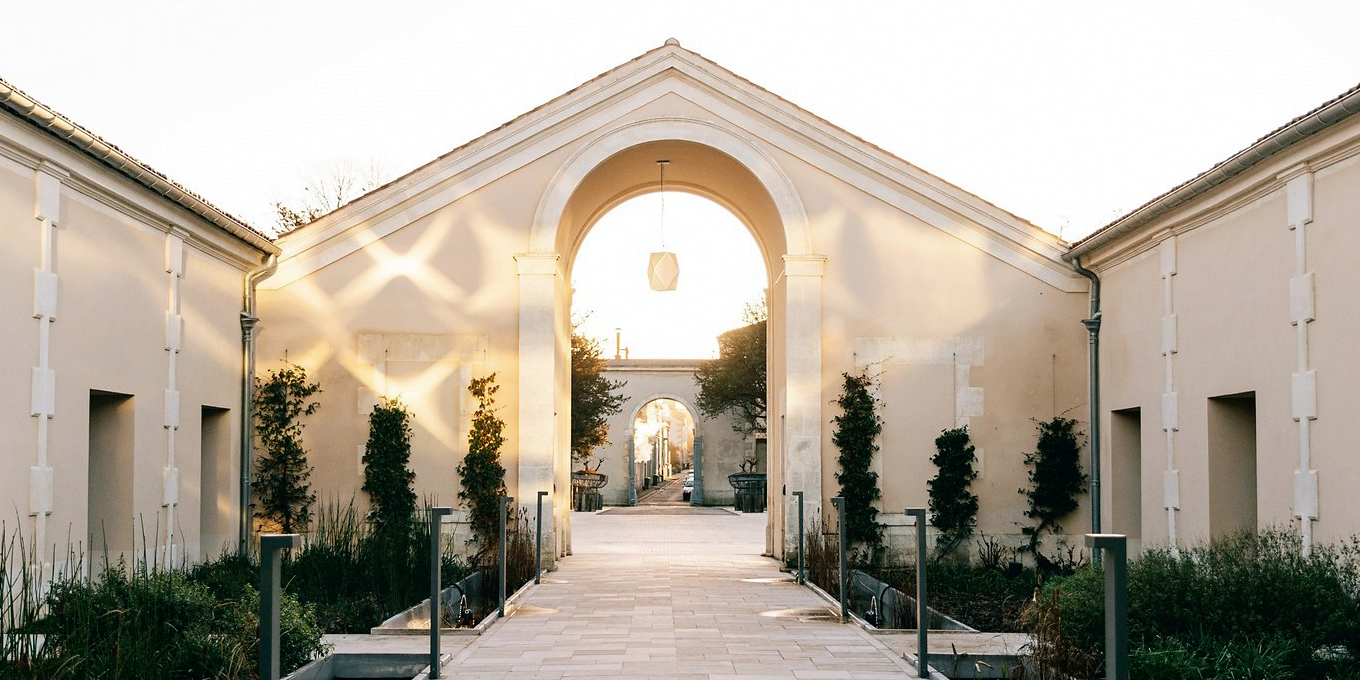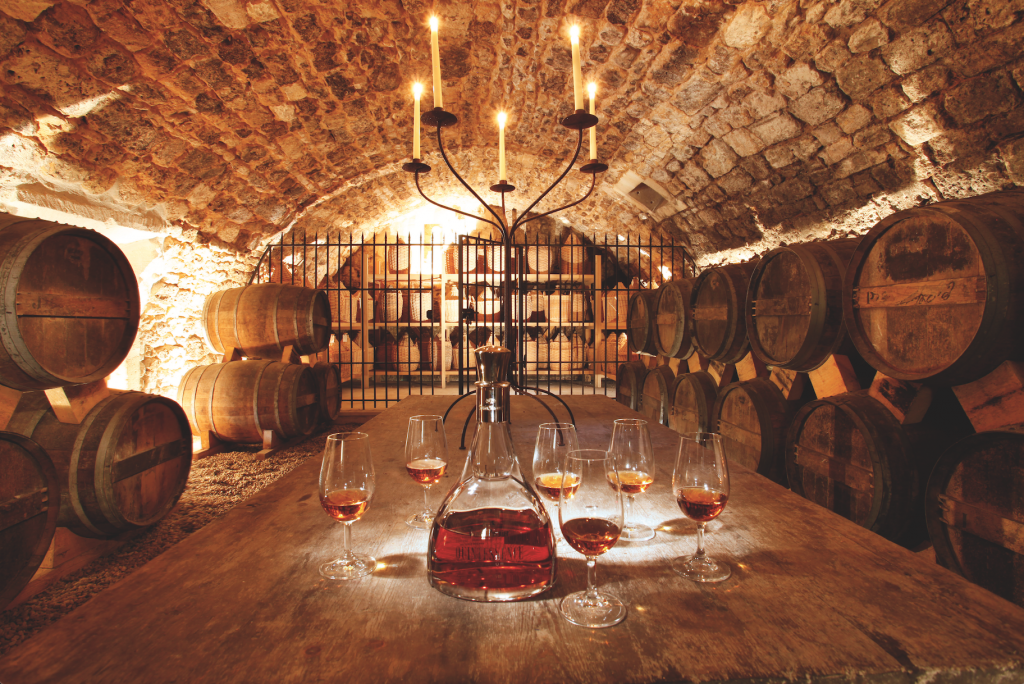Food & Drink
Cognac: A Journey of Discovery
There’s no better way to get to the bottom of this traditional French liqueur than by going straight to the source in France.
by : ELISABETH MASSICOLLI- Feb 24th, 2023

PHOTOGRAPHY, COURTESY OF CHAIS MONNET HOTEL & SPA (CHAIS MONNET HOTEL & SPA)
When I was excited to Cognac, France, to discover its delicious namesake, I didn’t think I was up to the task of fully appreciating all its nuances. Cognac was still filed under “boys club” in my mind, and I associated it with images of mustachioed gentlemen decked out in velvet smoking jackets and taking sips between cigar puffs or rappers swigging the good stuff straight from the bottle. That being said, I was open to embracing the adventure as I set off for Bourg-Charente in France, where you can find the vineyards and distillation headquarters of Bisquit & Dubouché—a cognac producer with roots over 200 years deep—as well as the distillery of Grand Marnier, the iconic liqueur of France’s belle époque, which has been finding the sweet spot between cognac and bitter citrus since 1827.
While on this spirited adventure, I fall in love with something I can only describe as “nectar”—it is smooth, slightly sugary, sometimes fruity, sometimes spicy and always throat-warming. Although it should be noted that my training wheels are in the form of several exceptional upmarket cognacs, including Bisquit & Dubouché XO (Extra Old), and the backdrop to the whole experience is one of the most charming regions in France. A more affordable version—VSOP (Very Special Old Pale)—is what truly sweeps me off my feet. “It’s also the favourite of many seasoned cognac lovers,” says Vincent Chappe, global ambassador for the venerable French brand. The cognac specialist, who was raised in the AOC (appellation d’origine contrôlée, a term used to certify the geographical origins of French agricultural products), explains the house’s distillation process from harvest to barrel, right down to the smallest details. According to Chappe, every Bisquit & Dubouché-made cognac is twice distilled for velvety smoothness. And I can taste it.
A VERSATILE SPIRIT
Purists prefer cognac straight up—neat or on the rocks. Cozying up to a majestic fireplace in the heart of Château Bisquit & Dubouché, however, Chappe confides that one of his favourite ways to imbibe cognac is…with ginger ale! So I try it and find I can get behind his preference—it’s delicious. For chilly fall evenings, he suggests making ice cubes with chai tea and then dropping them into your cognac of choice. Chappe doesn’t discriminate: Cognac can be savoured in a thousand and one ways, but the best is whichever one you like most.
Cognac comes in several varieties, so make sure you pick the right one for the occasion. Select finer cognacs to sample straight up, as drinking them this way allows you to fully appreciate their notes and subtle flavours—think Bisquit & Dubouché XO, with its smoked-tobacco, cacao, cinnamon and candied-fruit notes. For cocktails, you’ll want a lighter and fruitier cognac, such as the house’s VSOP, with its hints of honeysuckle, lemon and mango.
 Photo courtesy of GRAND MARNIER (BOURG-CHARENTE CASTLE)
Photo courtesy of GRAND MARNIER (BOURG-CHARENTE CASTLE)A BITTERSWEET NOTE
Speaking of cocktails, any bar worth its salt is home to a bottle of the iconic Grand Marnier. Aromatic and oil-rich bitter-orange peels that are dried, macerated and distilled give the French liqueur its signature citrus flavour. This divine distillation of bitter orange is blended with cognac to produce a beverage that’s ultra-rich, balanced and a mixologist’s match made in heaven.
Most people are familiar with the original Grand Marnier Cordon Rouge, which contains a young cognac and is frequently used in cocktails due to how well it imparts zest and freshness. But Grand Marnier also produces a higher-end version, Grand Marnier Louis-Alexandre, which is made with a VSOP cognac that’s aged in French-oak barrels, a process that brings out its spicier and fruitier notes and makes it a fabulous match for ginger syrup or tonic. If you prefer to savour Grand Marnier neat or on the rocks, treat yourself to a bottle of Grand Marnier Cuvée du Centenaire, a very expressive liqueur that boasts subtle dried fruit flavours and spices and is made with 11- to 35-year-old cognac. It’s a delectable digestif that I get to relish myself at the brand’s castle in Bourg-Charente, also known as the beating heart of the Grand Marnier brand. In the coming years, the château plans to open its doors to those who wish to brush up on their knowledge of the typically French beverage or even taste it for the very first time.
“You can sip on Grand Marnier liqueur without adding a thing—c’est magnifique—and it can also be a great stepping stone to enjoying cognac solo,” says Patrick Léger, the director of operations and master distiller at Grand Marnier and Bisquit & Dubouché and a Bourg-Charente native. He explains that the ways in which cognac and Grand Marnier are enjoyed have changed over time and that the younger generations are really catching on. “What we do is traditional, but we’re also creating for the future, drawing inspiration from and adapting to new tastes and the fast-paced movement of today’s world,” he says. “We’re trying to find more sustainable and creative ways to deliver our products—without ever sacrificing quality or flavour.”
WHERE TO GO IN AND AROUND COGNAC
To drink, eat and kick up your feet in style, make your way to these spots.
La Maison
Fine food and a well-rounded wine list in an unpretentious minimalist setting.
restaurant-lamaison-cognac.fr
La Ribaudére
A Michelin-starred restaurant with a menu designed by none other than chef Thierry Verrat. laribaudiere.com
Bistro de Claude
Seasonal fare and local specialties served in a warm, traditional bistro.
bistro-de-claude.com
Chais Monnet Hotel & Spa
A majestic luxury hotel built around a restored cognac cellar from the 19th century.
chaismonnethotel.com
Newsletter
Join our mailing list for the latest and biggest in fashion trends, beauty, culture and celebrity.
More from Food & Drink
Read Next

Beauty
Dyson Just Launched Its Most Intelligent Hair Dryer Yet
Get ready to upgrade your blowout game.
by : Lauren Knowles- Apr 25th, 2024

Fashion
Meredith Shaw Created a Plus-Size Summer Dress Collection That "Feels Like Candy"
The morning show host joined forces with PENN. to create a curated collection for sizes 14-32.
by : Allie Turner- Apr 25th, 2024

Culture
This University Elevates Women to New Professional Heights
You shouldn’t have to pause your life to move forward in your career.
by : ELLE Canada- Apr 16th, 2024




